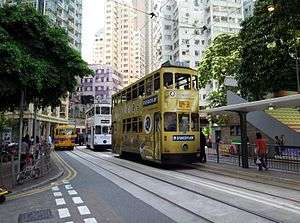Hong Kong Tramways
 | |
|
A Hong Kong double-decker tram | |
| Overview | |
|---|---|
| Locale |
|
| Transit type | Tramway |
| Number of lines | 6 |
| Number of stations | 120 |
| Daily ridership | 180,000 (2015)[1] |
| Website |
hktramways |
| Operation | |
| Began operation | 1904 |
| Operator(s) | Hong Kong Tramways Limited (Wholly owned by Veolia Transport – RATP Asia) |
| Number of vehicles | 163 |
| Technical | |
| System length | 13 kilometres (8.1 mi) (Track length 30 km/19 mi) |
| Track gauge | 3 ft 6 in (1,067 mm) |
| Electrification | Overhead lines, 550 V DC |
| Hong Kong Tramways | |||||||||||||||
| Traditional Chinese | 香港電車 | ||||||||||||||
|---|---|---|---|---|---|---|---|---|---|---|---|---|---|---|---|
| |||||||||||||||



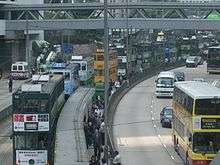
Hong Kong Tramways (Chinese: 香港電車) is a tram system in Hong Kong and one of the earliest forms of public transport in the metropolis. Owned and operated by Veolia Transport RATP Asia, the tramway runs on Hong Kong Island between Shau Kei Wan and Kennedy Town, with a branch circulating through Happy Valley.
Trams in Hong Kong have not only been a form of commuter transport for over 110 years, but also a major tourist attraction and one of the most environmentally friendly ways of travelling in Hong Kong.[2] The tram system is the only one in the world operated exclusively with double-decker trams, and is one of only three non-heritage tram systems in the world that use double-deck cars.
The tram is the cheapest mode of public transport on the island. The comparatively affordable fare is highlighted by Hong Kong Tramways' advertising slogan: "Hop on 1. $2.3. Tram so easy!"
History
Hong Kong's tram system was inaugurated using electric trams. It has never used horse or steam power.
Timeline
- 1881: Tramway system is proposed for Hong Kong.
- 1901: Proposal is accepted by Hong Kong Government.
- 1902: Hong Kong Tramway Electric Company Limited founded.
- 1902: Name changed to Electric Traction Company of Hong Kong Limited.
- 1903: Construction of a single-track system began, from Kennedy Town to Causeway Bay. The route was later extended to Shau Kei Wan.
- 1904: Bodies of the first fleet of 26 tramcars were built in the United Kingdom. They were then shipped in pieces Hung Hom to be assembled. The tramcars were all single-deck. Ten tramcars were designed for first class passengers and the others were for third class passengers. The first-class compartment was enclosed in the centre with two long benches on both sides, with both the front and back ends open. Seating capacity was 32 passengers. The third-class tramcars were open-sided, with six sets of benches running crossways, back to back, seating 48 passengers. Tram fares for the first and the third class were 10 cents and 5 cents respectively. Initially, the company planned to divide the trams into 3 classes, but subsequently only first and third class were chosen for ease of operation.
- 1910: Name of the company changed to The Hong Kong Tramway Company Limited.
- 1912: Owing to strong passenger demand, the first double-deck tramcar was introduced in 1912. The tramcar had an open top design, fitted with garden-type seats. The first class occupied the upper deck and one-third of the lower deck. Ten new tramcars were constructed.
- 1922: Electricity was contracted and supplied by Hong Kong Electric Co. Ltd (HEC). Company name changed to Hong Kong Tramways Limited.
- 1925: Enclosed double-decker trams replaced open-top trams.
- 1932: North Point Depot came into service.
- 1941: Japanese Occupation took place. Very limited tram service was provided. Only 12 tramcars were in operation daily from Causeway Bay to Western Market. One single-decker tram was used as freight transport.
- 1945: After three years and eight months of Japanese Occupation, all 109 tramcars still remained, but only 15 were operational. By October 1945, 40 tramcars were back in service.
- 1949: Single-track system was replaced by double-track system in August.
- 1950: Tramways undertook an extensive re-design and started building its own trams. Tram bodies adopted a "modern" design.
- 1954: North Point Depot closed and Russell Street Depot expanded and renamed Sharp Street Depot.
- 1964: Three locally made trams added, including the first single-deck trailer.
- 1965: Due to passenger demand, 10 single-deck trailers was introduced. The trailer was attached to the back of ordinary tramcar and designed to serve first class passengers only. The maximum capacity was 36 persons for each trailer.
- 1966: As trailers were well accepted by passengers, 22 single deck trailers were deployed in the fleet during 1966–67. Although trailers played a significant role in the tramways, they were finally withdrawn from the service in 1982.
- 1967: The last trailer built by the company.
- 1972: Class distinction abolished and flat fare introduced.
- 1974: The Hong Kong Tramways Limited acquired by Wharf Holdings
- 1976 – Drop-in coin boxes were installed on trams. A coin-box was fitted at the front exit, near the driver. Passengers had to drop in the exact fare on leaving the tram. Rotating turnstiles were fitted at the entrance, which is located at the rear of a tram. Conductors were no longer needed and most of them retrained to become motormen.
- 1986: Tram refurbishment has begun.
- 1989: Sharp Street Depot closed and terminus function split between Sai Wan Ho and the Whitty Street depots.
- 1992: Two double-deck trams made by Tramways were exported to the Wirral Tramway, Birkenhead, in the UK.
- 1992: Point Automation System deployed and points man system for altering the direction of tram manually was abolished.
- 2000: Coloured destination blinds had begun.
- 2000: Tramways launched the new "Millennium" tram on 24 October 2000, which was designed and manufactured by its own engineering team. The success of this tramcar marked an important milestone in the history of Hong Kong Tramways.
- 2001: The Octopus electronic smart card payment system introduced on trams.
- 2004: Hong Kong Tramways celebrates 100 years of service.
- 2007: Route map was re-installed on each tram stop. New driving panels were introduced in November.
- 2008: Air-conditioning was installed on antique tram #128.
- 2009: 50% stake and operating rights obtained by Veolia Transport RATP Asia; followed by full ownership by Veolia Transport RATP Asia.
- 2011: Hong Kong Tramways launched the seventh-generation tram on November 28, 2011. It is a combination of modern interior design with traditional tram body exterior. The face-lift allows tram’s iconic image to be maintained.
- 2014: Hong Kong Tramways celebrates 110 years of service.
- 2015: Following the opening of the West Island Line, daily tramway ridership drops 10% to 180,000.[1]
Ownership
- Hong Kong Tramway Electric Company Limited 1904-1974
- The Wharf (Holdings) 1974-2009; retained 50% stake from 2009 to 2010
- Veolia Transport RATP Asia 2010–present
Tram routes
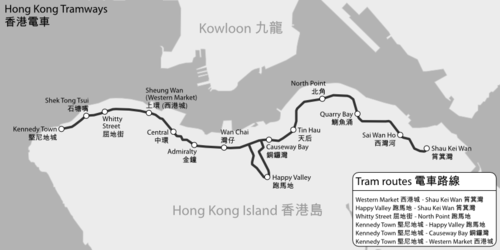

The trams run on a double track tramline built parallel to the northern coastline of Hong Kong Island from Kennedy Town to Shau Kei Wan, with a single clockwise-running track of about 3 km (1.9 mi) around the Happy Valley Racecourse.
There are 7 tram termini located along the tram line, namely, from west to east, Kennedy Town, Shek Tong Tsui (a.k.a. Whitty Street), Sheung Wan (Western Market), Happy Valley, Causeway Bay, North Point and Shau Kei Wan; some intermediate stops such as Sai Ying Pun, Admiralty MTR Station, Wan Chai, and Victoria Park are also equipped with crossovers so that they can be used as makeshift termini in emergency situations, such as en-route traffic accidents.
There are six major overlapping routes:
- Shau Kei Wan ↔ Western Market
- Shau Kei Wan ↔ Happy Valley
- Shau Kei Wan ↔ Kennedy Town
- North Point ↔ Whitty Street
- Happy Valley ↔ Kennedy Town
- Causeway Bay ↔ Whitty Street
- Western Market ↔ Kennedy Town
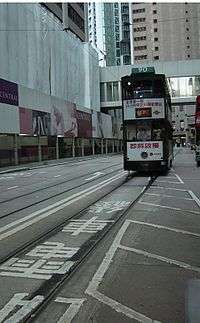
| Service hours | ||||
| From | Bound | Weekdays | Saturdays | Sundays and general holidays |
| Kennedy Town | eastbound | 05:10–23:54 | 05:07–23:57 | 05:12–23:54 |
| Western Market | eastbound | 06:00–00:02 | 06:01–00:00 | 06:13–00:00 |
| Happy Valley | eastbound | 06:34–23:10 | 06:34–23:10 | 06:34–23:10 |
| west bound | 05:59–00:37 | 06:00–00:40 | 06:04–00:37 | |
| North Point | westbound | 06:07–23:17 | 05:20–23:17 | 06:07–23:17 |
| Shau Kei Wan | westbound | 05:58–23:55 | 05:58–23:36 | 05:56–23:36 |
| average frequency during peak hours: 90 seconds | ||||
| Duration of journey (in minutes) | |||||
| Western Market | Causeway Bay | Happy Valley | North Point | Shau Kei Wan | |
| Kennedy Town | 23 | 55 | 60 | 70 | 80 |
| Western Market | – | 35 | 40 | 50 | 58 |
| Causeway Bay | 40 | - | 5 | 35 | 42 |
| Happy Valley | 35 | 5 | - | 15 | 25 |
| North Point | 50 | 15 | 35 | - | 15 |
Practical information
- Total length – 13 km (with a total track length of 30 km)
- Operating Hours – 5:30 am to 12:30 am
- Fare – HKD 2.3
On average, the headway between each tram departure is approximately 1.5 minutes during peak hours. In the past, trams had a maximum speed of 40 km/h. However, since early 2008, the maximum speed of some trams was increased, with a maximum speed of 50 km/h now enabled on most trams - a few of them even have a maximum speed of 60 km/h. The maximum capacity of each tramcar is 115 people.
Tickets
The current fare is HK$2.30 for adults, HK$1.20 for children under 12, and HK$1.10 for senior citizens 65 and above. Unlike most other forms of public transport in Hong Kong, fare charged is uniform regardless of the distance travelled. Monthly tickets are also available at the cost of HK$200, sold at Shek Tong Tsui, Causeway Bay, and North Point Terminus at the end of each month.
Passengers pay upon alighting by either depositing the exact fare in coins into the farebox, or by tapping the Octopus card on the processor. The turnstile at the tram entrance and closed circuit television prevent fare evasion by passengers.
Ordinary and antique trams are available for private hire. The open-balcony antique trams are often used for parties and promotional events. Tourists can also travel on the open-top trams through tours organised by the Hong Kong Tourism Board.
Fleet
Hong Kong Tramways now owns 163 double axle double-decker trams, including two open-balcony dim-sum tourist trams (Vehicle numbers 28 and 128) for tourist trips and private hire. There are three maintenance-only trams (Vehicle numbers 200, 300 and 400) which operate after tram service has stopped.
The trams themselves are sometimes called the "Ding Ding" (Chinese: 叮叮) by Hong Kong people, being the onomatopoeia of the iconic double bell ring trams use to warn pedestrians of their approach. The term "ding ding" is now often used to refer to the whole tram system, e.g. "travel by tram" (Chinese: 搭電車) as "take ding ding" (搭叮叮).
Hong Kong has the only fully double-decker tram fleet in the world. Most of the trams in operation were rebodied between 1987 to 1992. They are equipped with sliding windows. Since the early 2000s, these trams have been upgraded to provide better operating performance and safety. Almost all trams have full-body advertisements.
Fleet history
The tram fleet first consisted of 26 single-deck trams, with bodies 29 ft (8.8 m) long and 6 ft 1 in (1.9 m) wide, imported from England. However, they were quickly removed because of the rapid modernisation programmes. These tramcars were replaced by open-top double-deck tramcars from 1912 onwards. The introduction of permanent roofs for trams in 1923 was a big improvement to the system. In 1960s, adding trailers was proposed due to the increasing population and demands. In 1964, after testing a prototype built by Taikoo Dockyard in Hong Kong, 10 trailers were ordered from the UK and were added to the trams in Hong Kong in early 1965. Ten additional trailers were ordered from England in 1967, bringing the total number of trailers to 22. They were all withdrawn and scrapped by the end of 1982, since they used to derail frequently and were not economical to run – requiring a separate conductor for only 36 extra passengers.
Trams 12 and 50 are the only two trams still maintaining the original 1950s design, being restored at a railway museum in the United States and at a museum in Hong Kong, respectively. The cabins are varnished with their original light-green colour with teak-lined windows and rattan seats.
In 2000, three new aluminium alloy metal-bodied trams (officially called "Millennium trams"), #168 – 170, started operation. These trams have proven quite unpopular due to the poor ventilation in the summer – unlike on previous models, the front screen window cannot be opened to improve air-flow to passengers. A prototype air-conditioned tram, number 171, is under testing.

In 2007, a new maintenance tram was constructed, number 300, which is used to move trams in the depot. Besides electric power, it also uses a diesel motor.
Starting 7 November, new driving panels has been installed on trams after refurbishment. The first tram on the program was number 38.
In 2008, an air-conditioner was installed on the 'antique' tram #128.
Tram 88 is the first commuter tram installed air-conditioner, it has been started a three months testing scheme since 6 June 2016.[3]
Tram refurbishment
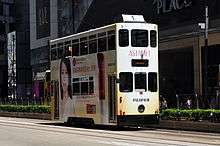
In October 2010, Veolia Transport showcased a prototype for the new model of trams. It plans to renovate the whole fleet at a cost of HKD 75 Million. The trams would keep their original exterior design, but the outer structure would be aluminium rather than teak as it is more durable. The benches on the lower deck would be replaced with single seats as well as a more modern look. Digital broadcasts would be placed inside trams to inform passengers of the next station, and LED lighting will be installed. AC motors and a new eddy current emergency braking system would be installed.[4][5][6]
Fleet details
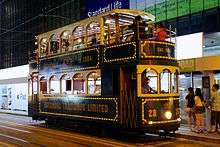
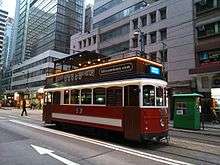
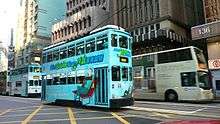
| Make/Model | Description | Fleet size | Year acquired | Year retired | Notes |
| Dick, Kerr & Company of Preston, England (#1–16, #27-36) and Electric Railway & Tramway Works Limited of Preston (a Dick Kerr subsidiary) (#17–26) First Generation cars | single deck cars – wood | 36 (reduced to 18 in 1912-1913, and further to 14 in 1923) | 1904–1905 | 1935 | |
| United Electric Car Company of Preston, England & Hong Kong and Whampoa Dock Co.of Kowloon, Hong Kong - Second Generation cars | double decker cars – wood | 28 (10 as new, 18 rebuilt from single deck cars) | 1912–1913 | 1924 (All were converted to fixed roof tram) | open-topped |
| English Electric Company Preston, England & Hong Kong and Whampoa Dock Co.of Kowloon, Hong Kong - Third Generation cars | double decker cars – wood | 48 (44 as new, 4 rebuilt from single deck cars, Second Generation cars also rebuilt with wooden fixed roof) | 1923–1924 | 1930 | new cars of first 16 cars fitted with canvas roof, others fitted with wooden fixed roof |
| Hong Kong Tramways, Hong Kong - fourth Generation cars (prewar) | double decker car – wood | 119 (57 as new, 62 were rebuilt from existing fleet) | 1925–1949 | 1955 | 62 trams were converted from: 14 first-generation trams and 48 third-generation trams |
| Hong Kong Tramways, Hong Kong - fifth Generation cars (1949, 1950s style) | double decker car – aluminium panels, teak frame | 163 (43 as new, 1 rebuilt in 1979 from a non-powered trailer car #1, others rebuilt from existing fleet) | 1949 (original #120), 1950-1964 (#121-162), 1979 (#163) | 1992 | |
| Hong Kong Tramways, Hong Kong - sixth Generation cars (current design) | double decker car – aluminium panels, teak frame | 160 – #120 (rebuilt in 1990s based on 1950s style) and rest from the 1980s (#1–27, 29–43, 45–119, 121–127, 129–143, 145–150, 151–163, 165–166) | rebuilt from 1986, 1987 – 1992 | ||
| Hong Kong Tramways, Hong Kong Millennium | double decker car – aluminium alloy | 4 (only 3 in service) – #168–171 | 2000 | #171 was an air-condition unit for internal testing, #168 rebuilt as VVVF drive vehicle | |
| Hong Kong Tramways, Hong Kong trailer cars | passenger single deckcars – aluminium alloy, (#1 – aluminium panels, teak frame) | 22 | 1964, 1965-1966 | 1982 (only #1 rebuilt as double decker car #163) | non-powered trailers |
| Hong Kong Tramways, Hong Kong - work car | single decker car | 1 – #200 (first generation) | 1956 | 1984 | |
| Hong Kong Tramways, Hong Kong - work car | double decker cars | 3 – #200, #300 and #400 | |||
| Hong Kong Tramways, Hong Kong - private hire cars | antique double deck cars – aluminium panels, teak frame | 2 – #28 and 128 | 1985, 1987 | private hire only | |
| Hong Kong Tramways, Hong Kong - first batch of VVVF drive vehicle | double decker car – aluminium alloy, (#172 – aluminium panels, teak frame) | 56 – #1, #11-13, #19, #23, #32, #35, #36, #40–42, #49, #52, #54, #56, #58, #60, #64, #66, #69, #70, #74, #77, #79, #94, #95, #99, #100, #106, #108, #109, #115, #116, #118, #122, #126, #129, #132, #133, #137, #141, #143, #146, #148, #154, #155, #157, #158, #162, #168, #171–175 | 2009-2016 | exterior of body based on fourth generation cars, but with Millennium cars interior, fitted with LED destination display | |
| Hong Kong Tramways, Hong Kong - sightseeing tram | antique double deck car – aluminium alloy | 1 – #68 | 2016 | 1920s style, used for sightseeing journey | |
| Hong Kong Tramways, Hong Kong - first air-conditioned commuter vehicle "Pilot Cooler Tram" | double deck car – aluminium alloy | 1 – #88 | 2016 | three months trial service from 6 June 2016 |
Note: Generally there is no specific/official 'generation' categories on tramcars. As many of the trams in one generation were in fact just modifications of the previous, such as open-top cars fitted with canvas roofs and then wooden roofs. The term 'generation' should only apply to the new designs.
Service fleet
- Mitsubishi Fuso Canter Overhead cable maintenance vehicle 6016[7]
- temporary truck stand or accommodation truck - used to place tram bodies or frames when trucks are removed for maintenance; stand has smaller wheels that allow it to move around depot[8]
Depots
Current depots
Two tram depots, located at Whitty Street in Shek Tong Tsui and Sai Wan Ho, are now in operation.
Whitty Street Terminus and Depot
Whitty Street, also known as "West Depot", is the location of the main depot for current operations. It previously operated as a terminus. When the Sharp Street Depot was closed, the site was expanded by 1.28 hectares on the Western reclamation in Sai Ying Pun leased from the Government, henceforth became the main depot.[9]
There is a two-storey workshop, which was responsible for rebuilds in the 1980s. Car #168, the newest in the fleet was built here.
Sai Wan Ho Depot
Sai Wan Ho became the "East Depot" after the closure of the Sharp Street Depot. This depot occupies a site of 0.7 hectares leased from the Government on a 5-year renewable tenancy.[9] It lies beneath the Island Eastern Corridor near Shau Kei Wan Road and Hoi Foo Street[9] and stores 56 cars.
Defunct depots
North Point Depot
With the upsurge in the number of trams, the original depot at Russell Street in Causeway Bay (the site of the current Times Square complex) became overcrowded by 1932, prompting Hong Kong Tramways to secure the North Point Depot site at King's Road for tram parking purposes (storage for 30 cars).
In 1951, the North Point Depot was closed.
Sharp Street Depot
A single comprehensive depot at Russell Street was the only depot of the system in its early days. It was able to house the whole tram fleet (approximately 120 cars). Upon further extension, the depot was renamed Sharp Street Depot. Sharp Street Depot was closed in 1989 and its services were divided between two new depots, the Sai Wan Ho depot (East Depot) and the Whitty Street depot (West Depot).
The Executive Council approved Tramways' plan to relocate its depots to Sai Wan Ho and Sai Ying Pun in July 1986, on the argument that the HK$3.5 million in operating costs would be saved. The company promised that tram fares would be unchanged until the end of 1988.[9] The old Sharp Street tram depot was decommissioned in 1988, and the Times Square commercial complex was constructed on the site.
Arsenal Street Depot
Arsenal Street Depot was the earlier of the HKT's storage facilities and replaced by Whitty and Sharp Street Depots. The depot was located where cars turned off from Queensway onto Arsenal Street (area is roughly where Asian House now stands at 1 Hennessey Road).
Alignment and interchanges
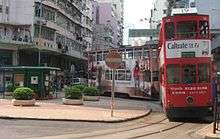
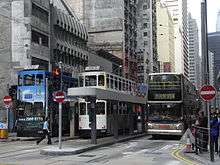
In many places, trams shares route along with other vehicles.
Most of the tram stop locations have remained unchanged since their establishment. However, some have had their names changed, e.g. "Shu Shun Kwun" (Chinese 書信館), referring to the then General Post Office building in the 1940s, is now called "Pedder Street" - the GPO building was demolished in the 1970s, and World-Wide House now stands on its site. In 1934, Hong Kong Tramways introduced loading islands (waiting areas) at some busy tram stops to ensure the safety of passengers. Today, there are 123 tram stops in total, most of them are sheltered refuge islands.
Just like buses, trams in Hong Kong can be very crowded. During the busier periods of the day, trams often line up since there are many tramcars running at the same time. In 2002, the trams recorded an average of 240,000 passenger trips daily.
Tram stops are densely located in an average interval of 250 metres (820 ft). Most of them are located in the middle of the road, connected by pedestrian crossings or footbridges. Major stops include Yee Wo Street stop at Causeway Bay, Pacific Place stop at Admiralty, and Prince's Building / The Landmark stop at Central.
Many termini of the Hong Kong Tramways are in the form of balloon loops, enabling the trams to reverse its travel direction efficiently.
The Island Line of the MTR is roughly parallel to the tramway line between Kennedy Town and Shau Kei Wan stations. Some sections of MTR tunnels are built directly under roads with tram tracks.
Public reception and cultural significance
The trams have not only been a form of transportation for over a century, but also a major tourist attraction. The well-preserved tram lines still serve as a crucial means of transport in Hong Kong. Travelling in the lower deck of the tram allows travellers to have a close up view of the local street life, while occupying the front seats of the upper deck gives good views of the town as the tram rattles by.
Hong Kong's tram system is an icon of the city, like other Asian trams in Kolkata, Dalian and Sapporo.
As they run through the urban area of Hong Kong Island, the tram tracks have become an important icon of urban Hong Kong. Since the tracks were originally built along the waterfront before further land reclamation pushed the coastline northwards, the tracks can be used to identify directions and locations throughout urban Hong Kong Island.
"Red light meals"
In the old days, the duration of meal breaks allocated to tram drivers were far from adequate. Most drivers would therefore take advantage of the time their trams are waiting at a red light to gulp down a portion of their meal before the signal turns to green, continuing this practice whenever the tram comes to a red light until the meal is finished. This kind of hurried, impromptu meal is commonly referred as "red light meals" (Chinese: 紅燈飯).
Projects
Current projects
Hong Kong Tramways Limited announced its interest in constructing a 12-km modern tramway system in the Kai Tak Development, built on the vacated site of the former Kai Tak Airport, in place of the "Environmentally Friendly Linkage System" (monorail system) proposed by the Hong Kong Government. Possible extensions to neighbouring places such as To Kwa Wan, Kowloon City and Kwun Tong were suggested. The company appointed a consultancy firm to investigate on the feasibility of building such a modern tram system in 2010, and submitted a proposal to the Development Bureau on April 29, 2013.[10]
The company pointed out that the cost of constructing the proposed tram system is HK$2.8 billion. which is comparatively low as compared to the cost of $12 billion needed for a monorail system. Bruno Charrade, Managing Director of HKT, said the design of tramcars can be in connection with their Hong Kong Island counterparts or in a totally new shape, depending on the Government's discretion.
Abandoned projects
There have previously been two separate extensions planned that were subsequently modified to be developed as light rail and metro systems.
New Territories tram system
During the development of Tuen Mun New Town in the 1970s, the Government had reserved space for the construction of a rail transportation system to serve the area. In 1982, the Government invited the Hong Kong Tramways to construct and operate a tram system in the area. The company initially expressed interest in the construction of the railway and intended to operate with double-decker trams, but later withdrew. The government then invited KCRC to construct and operate a light rail way. The system opened to the public on 18 September 1988. Since 2007, it is now known as the Light Rail.
Chai Wan Line
In 1970, Chai Wan on eastern Hong Kong Island was developed into a residential and industrial area, which greatly increased the traffic demand to Central. Extending the tram line from Shau Kei Wan to Chai Wan was considered, but was ultimately rejected due to low cost-effectiveness, as hills exist between Chai Wan and Shau Kei Wan, and difficulties arise from tunneling through the hills to make level track. It was replaced by the Island Line service — linking Chai Wan and Admiralty — which was opened to the public on 31 May 1985.
Bibliography
- R.L.P. Atkinson, A.K. Williams (1970). Hongkong Tramways: A history of Hongkong Tramways Limited, and predecessor companies. Light Railway Transport League. ISBN 978-090-04333-1-3.
- Barnett, Martin (1984). Tramlines: The Story of the Hong Kong Tramway System. South China Morning Post. ISBN 962-100-032-7.
- Davis, Mike (2004). Hong Kong Trams — Hong Kong Tramways 100 Years. ISBN 1-900515-95-4.
- Jones, Martin (1984). Tram Jam: The Hong Kong Tram Collection. Presstram. ISBN 962-711-801-X.
- Joseph, Tse; Lau, Ricky (2012). Amazing Ding Ding. ISBN 978-988-219-819-7.
- Lee, Eric (2012). A Centenary Date with Hong Kong Tramways. Tramric & Hong Kong Tramways Ltd. ISBN 978-988-16655-0-8.
- Liu, Bona; Lee, Eric; et al. (2013). Tram Art Gallery. Tramric & Hong Kong Tramways Ltd. ISBN 978-988-16655-8-4.
- WE LOVE TRAM. Hong Kong Tram Enthusiasts. 2011. ISBN 978-988-19956-4-3.
- Lee, Eric (2016). Hong Kong Tramways: Across the City, Across the Century. ISBN 978-988-83669-6-5.
See also
- Transport in Hong Kong
- MTR
- Changchun Tram
- Trams in Dalian
- Shanghai tram
- Tianjin tram
- Hong Kong Trams Station
- Wirral Transport Museum - operates two HKT built (at Whitty Depot 1992) cars, 69 and 70, delivered in 1994
References
- 1 2 Sung, Timmy (4 March 2015). "Tram passengers down 10pc after opening of MTR West Island line". South China Morning Post. Retrieved 12 March 2015.
- ↑ "Environmental Friendliness, Hong Kong Tramways".
- ↑ Yeung, Raymond. "Hong Kong tram operator offers air-conditioned car". South China Morning Post. Retrieved 7 June 2016.
- ↑ "Railway Gazette: Redesigning Hong Kong's iconic trams".
- ↑ Sound recording of the AC propulsion in Tram 173 on YouTube
- ↑ http://www.thestandard.com.hk/news_detail.asp?we_cat=4&art_id=117495&sid=34606330&con_type=1&d_str=20111129&fc=1
- ↑
- ↑ https://hkgtrams.wordpress.com/2011/03/02/whitty-street-depot/
- 1 2 3 4 Plan to relocate depot keeps tram-fares down, South China Morning Post, 16 July 1986
- ↑ Fight for Modern Tramway at Kai Tak Hong Kong Facebook Page
Further reading
- Wong, Hiufu (2014-03-26). "How to ride Hong Kong's tram system". CNN. Retrieved 2016-06-07.
- DeWolf, Christopher (2013-09-30). "Rethinking Hong Kong's Trams". URBANPHOTO: Cities / People / Place. Retrieved 2016-06-07.
- Mullany, Gerry (2013-10-14). "Modern Subways Zip Below, but a City's Trams, Slow and Sweaty, Plod On". The New York Times. Retrieved 2016-06-07.
External links
| Wikimedia Commons has media related to Trams in Hong Kong. |
